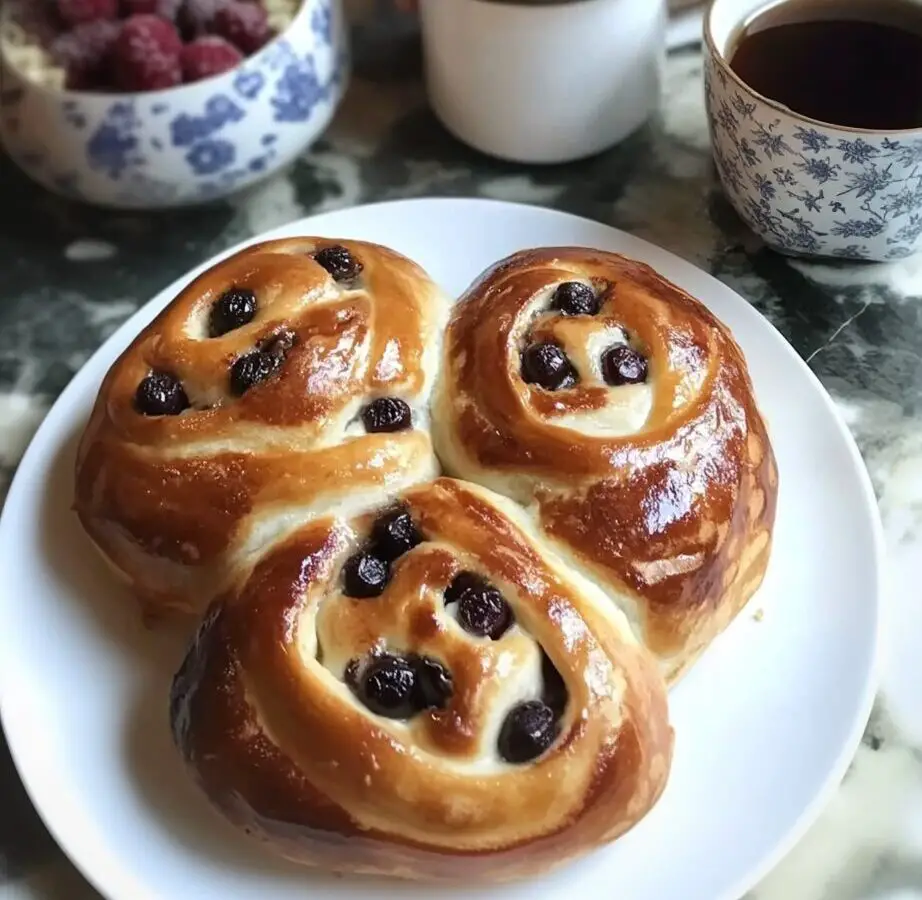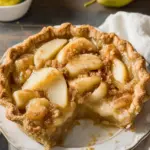Chelsea Buns are a traditional British sweet treat, characterized by their soft, spiced dough filled with dried fruits and glazed with a sticky syrup. Originating in the 18th century at the Chelsea Bun House in London, these buns are a delightful addition to any tea time or breakfast spread. Unlike cinnamon rolls, Chelsea Buns incorporate mixed spices and dried fruits, offering a unique flavor profile that’s less sweet but equally satisfying.
Full Recipe:
Ingredients
For the Dough:
- 150ml milk
- 1 egg
- 350g strong white bread flour
- ½ tsp salt
- 50g granulated sugar
- 50g unsalted butter, softened
- 7g active dry yeast
For the Filling:
- 50g unsalted butter, melted
- 75g golden raisins
- 75g currants
- 50g light brown sugar
- 1 tsp mixed spice
For the Glaze:
- 2 tbsp granulated sugar
- 2 tbsp water
Directions
Making the Dough:
Using a Bread Machine:
- Pour milk and beaten egg into the bread machine pan.
- Add flour, salt, sugar, and softened butter.
- Make a small well in the center and add the yeast.
- Set the machine to the “Dough” cycle.
- Once complete, allow the dough to rise until doubled in size.
Using a Stand Mixer:
- Dissolve yeast in warm milk and let it sit for a few minutes.
- Stir in the beaten egg.
- In the mixing bowl, combine flour, salt, sugar, and softened butter.
- Add the milk mixture and knead using the dough hook until smooth.
- Cover and let the dough rise in a warm place until doubled in size.
By Hand:
- Follow the stand mixer instructions, mixing ingredients with a spatula until a sticky dough forms.
- Turn onto a floured surface and knead until smooth.
- Place in a floured bowl, cover, and let rise until doubled in size.
Preparing the Filling:
- In a bowl, mix golden raisins, currants, brown sugar, and mixed spice.
- Set aside until the dough is ready.
Assembling the Buns:
- After the dough has risen, gently knead it and roll out into a 12″x18″ rectangle.
- Brush the surface with melted butter.
- Evenly sprinkle the fruit mixture over the dough.
- Roll the dough tightly from the long edge to form a log.
- Cut into 9 equal slices.
- Place slices cut-side up in a greased 9″ square baking pan.
- Cover and let rise until the buns fill the pan.
Baking:
- Preheat the oven to 200°C (400°F).
- Bake the buns in the center of the oven for 15–20 minutes, or until golden brown and well risen.
Glazing:
- While the buns are baking, combine sugar and water in a small saucepan.
- Heat until the sugar dissolves and the mixture boils.
- Remove from heat.
- Immediately after removing the buns from the oven, brush them generously with the glaze.
- Allow to cool slightly before serving.
Nutritional Information (Per Bun)
- Calories: Approximately 363 kcal
- Fat: 8g
- Saturated Fat: 5g
- Carbohydrates: 62g
- Sugars: 25g
- Fiber: 2g
- Protein: 9g
- Salt: 0.62g
The History and Origins of Chelsea Buns
Chelsea Buns are a classic British pastry with a rich history dating back to the early 18th century. Named after the Chelsea Bun House in London, a famous bakery that operated from 1760 to the early 19th century, these buns quickly became a beloved treat across England. The Chelsea Bun House was well-known for its sweet, sticky buns that featured a unique blend of spices and dried fruits wrapped in a soft, yeast-based dough. The buns were especially popular with London’s working-class population, who enjoyed them as an affordable, sweet snack or breakfast item.
What makes Chelsea Buns stand out from other similar pastries like cinnamon rolls is their distinctive flavor profile. Instead of relying heavily on cinnamon, these buns incorporate mixed spices such as nutmeg, allspice, and sometimes even a hint of cloves. Additionally, the use of currants, golden raisins, and occasionally other dried fruits adds a chewy texture and bursts of natural sweetness that complement the spiced dough beautifully. The buns are traditionally finished with a sugar glaze that caramelizes during baking, creating a glossy, sticky top that’s irresistible.
Cultural Significance and Popularity
Chelsea Buns have transcended their humble origins to become a staple in British baking and tea culture. They are often enjoyed during afternoon tea, alongside other pastries and sandwiches, making them part of the quintessential British teatime experience. Their appeal goes beyond the UK as well, with many home bakers and enthusiasts around the world adopting the recipe and adapting it to local tastes.
The buns’ combination of spice, fruit, and sweetness makes them versatile enough to serve at various occasions, from casual breakfasts to special gatherings. Over time, numerous variations have emerged, with bakers experimenting by adding nuts, different dried fruits, or even a cream cheese glaze to create new flavors while maintaining the essence of the original recipe.
Texture and Flavor Profile
One of the defining features of Chelsea Buns is their texture. The dough is enriched with butter and sugar, which gives it a tender crumb that’s soft but still substantial enough to hold the fillings. The slow fermentation of the yeast dough allows for the development of complex flavors, resulting in a slight tanginess that balances the sweetness from the sugar and dried fruit.
The mixed spice blend imparts warm and aromatic notes without overpowering the natural sweetness of the fruits. The raisins and currants soften during baking but still retain a bit of chewiness, creating a pleasing contrast to the pillowy dough. The final glaze adds a sticky, glossy finish, enhancing both the look and taste of the buns.
Why Chelsea Buns are Perfect for Breakfast and Tea Time
Chelsea Buns are ideal for breakfast or a mid-afternoon snack because they offer a comforting, mildly sweet treat that pairs excellently with tea or coffee. Unlike some overly sugary pastries, the spice and fruit in Chelsea Buns create a more balanced sweetness that won’t overwhelm your palate early in the day.
Their portability and ease of serving make them a popular choice for packed breakfasts or tea parties. You can enjoy them warm or at room temperature, and they hold up well even a day or two after baking if stored properly. Warming them slightly before serving can help revive their softness and bring out the aroma of the spices.
Tips for Baking the Perfect Chelsea Buns
To achieve bakery-quality Chelsea Buns at home, attention to detail is important. The key is to prepare a soft, elastic dough that’s allowed to rise sufficiently, which will result in a light and airy texture. Using fresh yeast or active dry yeast and proofing it correctly ensures a good rise.
When rolling out the dough, it’s essential to keep it an even thickness so the buns bake uniformly. Don’t overfill the buns with dried fruit or sugar, as this can cause the filling to leak during baking or make the buns overly sweet.
Another important factor is the glazing process. Applying the sugar syrup glaze immediately after baking allows it to soak into the buns while they’re still warm, creating that signature sticky, shiny surface.
Nutritional Considerations
Chelsea Buns, while delicious, are an indulgence and should be enjoyed in moderation, especially for those monitoring sugar or calorie intake. Each bun contains a fair amount of carbohydrates and sugars due to the flour, sugar, and dried fruits. The butter and egg in the dough add fat and protein, contributing to satiety but also calories.
For those looking to make a healthier version, you might consider reducing the sugar in the dough or filling, or incorporating whole wheat flour to increase fiber content. Another option is to experiment with dried fruit varieties that are lower in sugar or adding chopped nuts for extra protein and healthy fats.
Modern Variations and Creative Twists
While the traditional Chelsea Bun recipe remains a favorite, many bakers enjoy putting their own twist on it. Some modern versions include adding cinnamon or cardamom to the spice mix to enhance the warmth of the flavor. Others swap out the raisins and currants for dried cranberries, chopped apricots, or even chopped dates.
For a richer dessert-style bun, some add a drizzle of icing or cream cheese glaze after baking instead of the classic sugar syrup. Savory variations have also been explored, where the sweet filling is replaced with cheese and herbs for a unique twist.
Pairing Suggestions
Chelsea Buns are versatile enough to be enjoyed on their own or paired with a variety of beverages and accompaniments. They are perfect with a cup of traditional English breakfast tea, Earl Grey, or a strong coffee. For a cozy treat, serve warm with a pat of butter or a smear of clotted cream.
For an afternoon tea spread, Chelsea Buns can be accompanied by finger sandwiches, scones, and other pastries for a full British tea experience. Their slightly spiced, fruity flavor also pairs well with fresh fruit preserves or marmalades.
Storing and Reheating Chelsea Buns
Chelsea Buns are best enjoyed fresh, but they keep reasonably well for a couple of days when stored in an airtight container at room temperature. To maintain softness, avoid refrigeration as it can dry the buns out.
If you want to store them for longer, freezing is a great option. Wrap the buns individually or as a batch in plastic wrap and place them in a freezer-safe bag. When ready to eat, thaw at room temperature and warm gently in the oven or microwave.
Conclusion
Chelsea Buns are a timeless British pastry that combines a soft, spiced dough with sweet dried fruits and a sticky glaze to create a uniquely flavorful treat. Their rich history and cultural significance make them more than just a simple bun; they are a symbol of traditional British baking and teatime hospitality.






